Advertisement
This exclusive book excerpt takes us aboard a boat named Sleuth to see what really happened during the catastrophic Fastnet Race of 1979 — before the age of pinpoint weather forecasting that would have warned that a lethal storm was brewing.
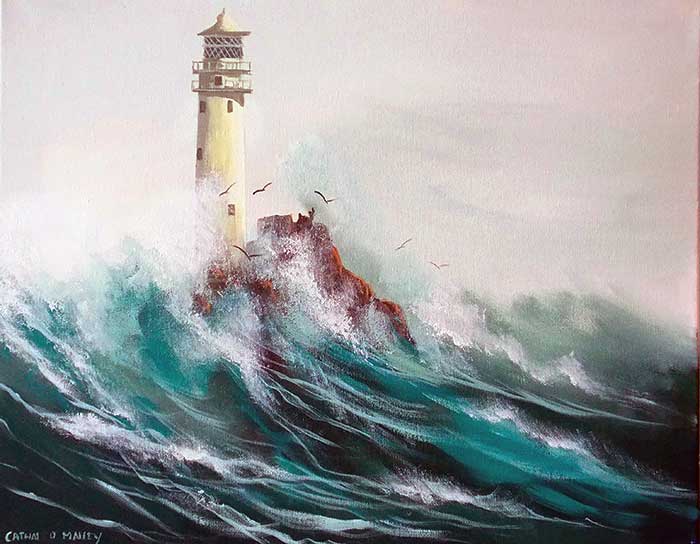
Fastnet Rock. (Illustration: Cathal O'Malley)
A new book, Offshore High, pulls back the curtain on the wild world of international grand prix sailboat racing and its characters — from the boozy Ted Turner to the gentile King of Norway and every financial scion, racing champion, and famous hanger-on in between. The story is from the point of view of one of racing's tactical geniuses, Steve Colgate, and his visionary wife, Doris.
Offshore High also covers the past century in one of America's family dynasties, the Colgates of Colgate-Palmolive fame, who lost their fortune over a point of honor. A young son, Steve, carried the Colgate name but none of its riches, joined the Air Force, then taught sailing for a living. Doris later added the rocket fuel, and together they built the most formidable sailing school network in the world.
Offshore High is about two of boating's rock stars and the iconic Offshore Sailing School they built from scratch — a great book for anyone who loves reading about famous boats and people, racing strategy, building a business, and the power of hard work and sportsmanship.
Autographed copies at a special price just for Members
Order an autographed hardcover edition of Offshore High and receive an exclusive discount for BoatUS Members! Normally $39.95, Members receive 20% off using code BOATUS at checkout. Visit offshoresailing.com/offshore-high to order. Unsigned copies are available from most bookstores or online retailers.
Looking back at what came to be called "the deadliest storm in the history of modern sailing," perhaps the most remarkable fact of all is that it could not have begun more tranquilly.
The 28th and most infamous edition of the Fastnet, organized by the proper Royal Ocean Racing Club, had set forth from the quintessential English seaport of Cowes, on the Isle of Wight, on the pleasant Saturday afternoon of August 11, 1979. With a forecast of moderate to fresh southwesterly breezes ranging from roughly 10 to 20 knots — simply perfect for sailboat racing — a huge spectator fleet gathered off the starting line in The Solent, the narrow body of water separating the island from mainland England, to bid farewell to the impressive Fastnet roster of over 300 yachts and 2,500 competitive sailors. One couldn't have conjured a prettier scene, the very epitome of classic British yacht racing.
By the time the last boat completed the race, on August 17, 15 people had died, 24 crews had abandoned ship, five yachts had sunk, 136 sailors had been rescued, and only 85 yachts had successfully finished. Overall, the '79 Fastnet had been nothing less than pure, unbridled carnage. Those who sailed the race witnessed something that, thankfully, had never been seen before nor hasn't since, including skipper Steve Colgate and his crew aboard the 54-foot ocean racer, Sleuth.

Steve Colgate at the helm of Sleuth.
The dozen sailors aboard Sleuth were a truly international crew with several Americans including navigator Peter Nalle; vastly experienced English sailor Peter Wilson; and Bruno Caire, an opinionated Frenchman who'd competed in the tough, prestigious Whitbread Round-the-World Race. They were all about to have their hands full.
Much has been written about what went wrong in the 1979 Fastnet. It's true that with the tools modern navigators possess, including advanced forecasting models and broadband communications, that such a catastrophe couldn't possibly happen today. But it was a very different nautical world into which the Fastnet crews set sail over four decades ago. At that time, Fastnet sailors received a single daily shipping forecast via high-seas radio that was basically valid for 24 hours ... and even then was sometimes just plain inaccurate. Which was woefully inadequate for the rapidly forming storm that the atmosphere dished up off the United Kingdom in mid-August of 1979.
What happened, in a nutshell, was that with exquisite, horrible timing, a deep low-pressure system and its corresponding cold front rendezvoused with the racers as most were well into the Irish Sea on the way to Fastnet Rock, the midway turning mark of the race. When that occurred, the southwesterly gale that had not been expected or forecast, but which most boats were in the midst of successfully negotiating, almost instantly became a similarly undetected northwesterly gale following a slamming 90-degree wind shift. The big breeze was an issue, but the more dangerous problem was the sea state and the colossal, confused waves created by the confluence of the rapidly colliding systems from different directions. And of course, there was the further complication that nobody had any clue that it was coming. Yikes.

The forecast was clear before the 1979 Fastnet star.
For the Fastnet fleet, their collective fate at that stage basically came down to that familiar all-purpose summation of woe: wrong place, wrong time. Later, Steve would write a straightforward account of Sleuth's Fastnet experiences for an article that ran in the November 1979 issue of Yachting magazine. "Our first sign that a low-pressure area was approaching came as the wind increased late Monday afternoon, August 13th," he wrote. "We were running on port tack (before the breeze) when the wind started coming forward," he continued, pinpointing the moment when the wind direction began to switch from south to north. Which is when the heavy spinnaker they'd set "blew in half " and the crew quickly cleared up the mess and hoisted a medium-sized headsail.
"The barometer was dropping fast as we spotted the light of Fastnet Rock about 18 miles ahead," he continued. "By 2300 (11 p.m.), the wind velocity across the deck measured about 45 knots on our anemometer. We had taken two reefs in the mainsail and changed from the (medium headsail to a smaller one) in preparation for rounding."
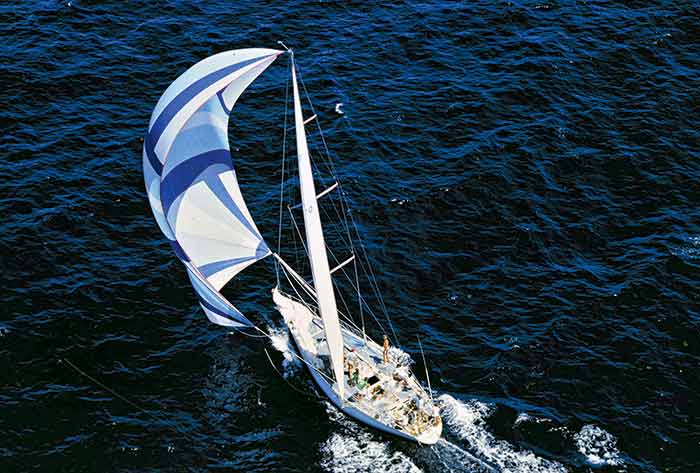
The Colgates' 54-foot Sleuth sets sail in perfect wind conditions. (Photo: Beken of Cowes)
As the wind strengthened to 50 knots, Sleuth's crew successfully tucked a third reef into the main, but it wasn't easy. And now, everything was moving fast. Very fast.
Steve wrote, "By the time the reefing job was completed, we were in the process of coming up close-hauled to tack around Fastnet Rock. It was hard to judge how far we were from the rock, but we gave it a wide berth. I then had to judge when to tack onto starboard. When the rock was well abaft (our beam) we tacked, but we seemed to be going sideways almost as fast as we were passing the light. We appeared to be getting very close to the rock, which we couldn't see at all. We could only see the light, rotating far above us, drawing us in like a magnet. I ordered the engine started in case we went into irons trying to tack at the last moment. Fortunately, neither a tack nor the engine was necessary. We rounded about midnight."
Soon enough, as the boat started pounding to windward, a third of Sleuth's crew went down hard, incapacitated by seasickness. And a new challenge arose: As Sleuth sailed southward back toward England, she was on a reciprocal heading to the dozens and dozens of smaller boats bound north toward the rock. At the wheel, it was Steve's job to identify the lights of the oncoming fleet and dodge them the best he could. It was exhausting work, with no room for error.
Even so, while Steve knew the situation was precarious, he also realized he had a good boat and crew, and things were as under control as they possibly could be. Back ashore, however, as the first news reports began filtering in that something was seriously amiss in the Fastnet race, the suddenly worried loved ones fretting over their sailors at sea had no such comfort. Including Steve's wife, Doris, and his mother, who just happened to be on a road trip down the south coast of England to welcome Sleuth back at the finish in Plymouth. It was a journey neither would ever forget.
But Doris had been all in on Sleuth when they'd purchased her. Most of Steve's other accomplishments in yacht racing had been, paradoxically, as the critical crew, the ringer who came aboard to ensure victory. She wanted him to be in command of his own boat, to make his own decisions, and savor his own results. Yet now, incredibly, he was smack-dab in the middle of one of the worst storms of the century.
And it was his show to run. All his.
What's the saying? Careful what you wish for?

1. Satellite images show the position of a devastating cold front from August 12-13, with its abrupt 90-degree change in wind direction toward the fleet. 2. Barometric pressure drops rapidly to 982 millibars (lower pressure equals higher wind speed, which reached 80 knots), with short, steep seas and 50- to 60-foot waves. 3. The storm moves off August 14. (Photos: Neodaas/University of Dundee)
CHAOS ENSUED. By the fourth day of the Fastnet, aboard Sleuth shortly before sunrise on the hellish morning of Tuesday, August 14, Steve ducked below, sidled into the navigation station, and recorded the briefest of observations for the 0400 (4 a.m.) entry in the ship's logbook: "Hairy."
Indeed.
Fastnet Rock was miles behind him. Several of his crew were scattered in berths fore and aft, sick as dogs. One of them was his navigator, which meant that in addition to long spells at the wheel, Steve also had to keep keenly abreast of Sleuth's speed, course, and position; GPS receivers, with precise push-button navigation info, had yet to be invented.
Back on deck, God only knew what the wind speed was. Sleuth's anemometer, which measures the strength of the breeze, had pegged out at its top-range figure of 60 knots. That had been a while ago. Steve guessed it was now 80 or 85 knots, with corresponding seas of 25 feet. One of the crew reported hearing "mayday" calls on the VHF from the slower boats back in the fleet. He could hear rescues in progress and something about a drowning.
"It was getting worse and worse," he said.
The next geographical mark on the racecourse that had to be avoided was Bishop Rock, a rocky sea stack in the westernmost Scilly Isles, roughly 30 miles off the mainland coast of Cornwall. It was not only a physical waypoint, but a psychological one. Bishop signified the entrance to the relatively protected waters of the English Channel. Once Sleuth had safely negotiated Bishop Rock, the end of the nightmare would be near.
Getting there, of course, wasn't easy. Steve picked up the action in his Yachting article:
"Any lack of attention by the helmsman could have been disastrous. The sails were holding up well, but if we swung too much broadside to the wind they started to flog. In 70- to 85-knot winds it doesn't take long to rip a flogging sail. We had a staysail ready to go up in case that happened, but the main thing was to avoid flogging in the first place. One crewman lost his grip and was washed down the deck, but his safety harness kept him aboard. From then on I ordered only the two most experienced helmsmen on each watch to steer and we had no further trouble."
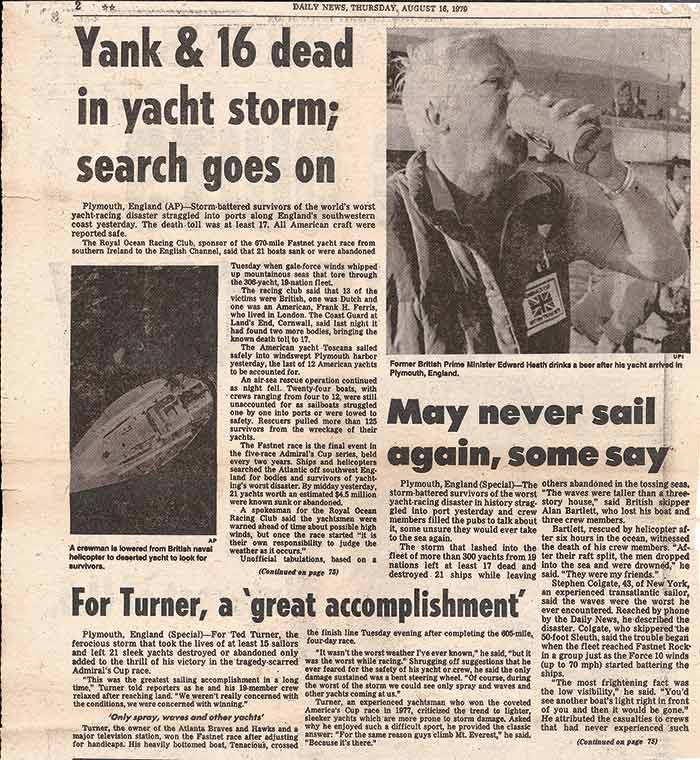
By August 11, a storm that would become infamous was rapidly upon the 303-boat fleet already well out to sea. Survivors reported 60-foot waves and 80-knot winds.
Down below, at the nav station, Steve suddenly was faced with a different dilemma when unexpectedly confronted by arguably the most experienced sailor on Sleuth's crew, Bruno Caire, the French veteran of the Whitbread race. "Steve," he said, in both his heavily accented English and within earshot of everyone else either off watch or ill in their bunks, "we have zees problem."
"Well, Bruno," Steve replied, patiently. "What is that?"
"We are heading for zee Scilly Isles." Caire needn't have uttered another syllable. He and Steve — and everybody else eavesdropping — were well versed in nautical lore and did not require a further reminder of the maritime disaster of the early 1700s, when a quartet of Royal Navy ships piled into the Scillies in a blow not unlike the one they were experiencing, with the loss of upwards of 2,000 men.
It was a "buck stops here" moment for Steve. He had to get ahead of it. Immediately.
Steve actually understood Caire's concern. At the moment, though still many miles away, Sleuth was more or less bound straight for the Scillies. That's because Steve had charted a course to keep the boat on a beam reach, the fastest, safest point of sail, on which it was making a quick 10 to 12 knots. Yes, he could've hardened up onto the wind, but that would've made the efficient sailing untenable, and much slower to boot. He also understood that he didn't have to. Sleuth, he knew, was sailing into the low-pressure trough, which meant the wind would shift in their favor, and Sleuth would be safely lifted past Bishop Rock. What was required now was patience.
"I knew everyone was listening," Steve said. So, he asked Bruno a couple of straightforward questions: Are we going fast, with the right sails? Bruno answered affirmatively.
"When we have a problem, we'll address it," Steve replied. "But we don't have one now."
And that was that. "He never said another word," Steve later said.
The wind shift Steve expected kicked in, hours later, just as he forecast. Sleuth slipped past Bishop Rock and the Scillies uneventfully. Then the breeze "lightened" to 40-odd knots ... and Steve called for the crew to hoist a spinnaker!
"It's all relative," he said. "When it's blowing 80 and drops to 40, it's like, damn, there's no wind."
Sleuth cruised across the finish line a little after sunrise the next day. She'd not only finished the historic '79 Fastnet, she'd won her class.
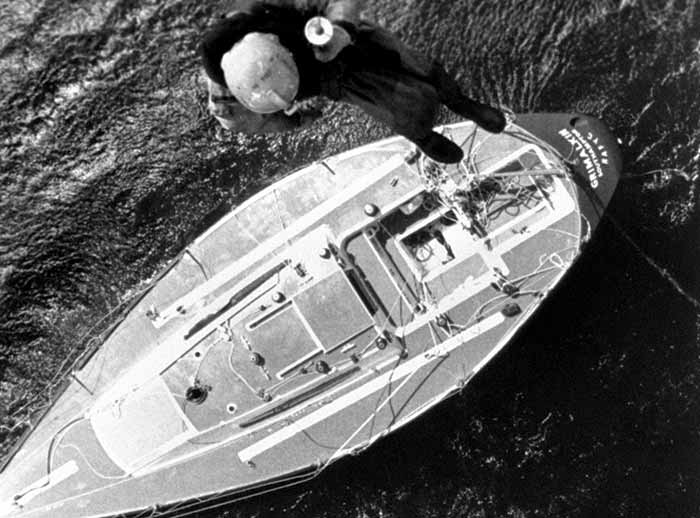
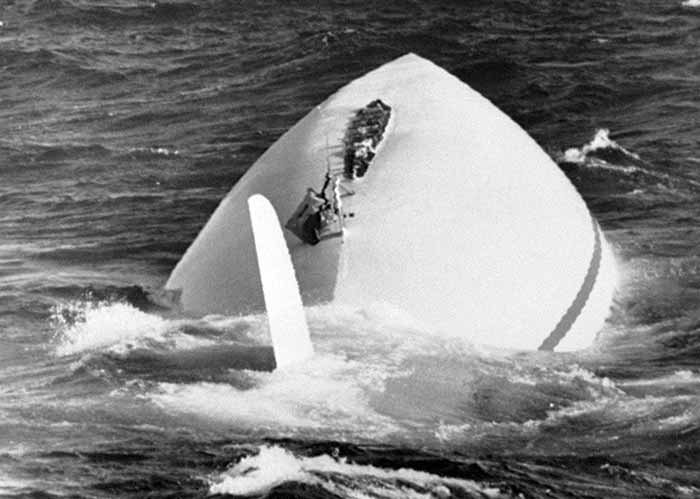
British and Irish rescue crews check damaged and broken boats for survivors. In the end, 24 crews had abandoned ship, 15 people were dead, five boats had sunk, and 136 sailors were rescued. (Photos: PA Images/Alamy Stock Photo)
FOR DORIS, her personal memories of the 1979 Fastnet Race do not involve witnessing firsthand a once-in-a-lifetime survival storm, or class-winning decisions under extreme duress. But Doris did experience a rather surreal Fastnet journey of her own: a road trip in a rental car, stacked with crew gear, with the wives of a couple of other Fastnet sailors and her imperious mother-in-law, Nina Colgate.
Once the Fastnet had begun, Doris and Nina loaded up the rental car with all the crew's regular clothes and formal wear for the parties held in Cowes, and with her two other passengers, drove down the coast of the Isle of Wight to watch the racers sail past the famous Needles and out of sight. Then it was on to the ferry to Southampton, and westward along the coastline toward Plymouth. As they crossed the plains of Dartmoor, the wind really started kicking in and their heavily loaded vehicle was rocked, but they had no radio nor any idea what was unfolding on the racecourse.
By the time they arrived in Plymouth, and their rooms at the Holiday Inn, the early reports of a pending disaster were everywhere. Doris commanded Nina to "go to your room," which proved to be a bad idea as she watched, in rapt horror, as the entire unholy episode unfolded on her TV set. In the meantime, Doris and some of the wives of other Fastnet crews raced to the yacht club, desperate for news.
It was a long, long night. The next day, back at the yacht club, Doris learned there was still no word on Steve or his crew until she overheard a German reporter saying something about another boat that had been accounted for and was making its way to the finish line: "Sloosh." She understood what he meant. Her relief was palpable. She knew Steve and the boys were safe.
As often happened on Sleuth, they arrived engineless, limping in. When Steve made it back to the hotel and knocked on his mother's door, as she opened it, she cried, "My son, my son!" and enveloped him in an embrace. It was, to the best of his recollection, the first real hug from his mother that he'd ever received.
